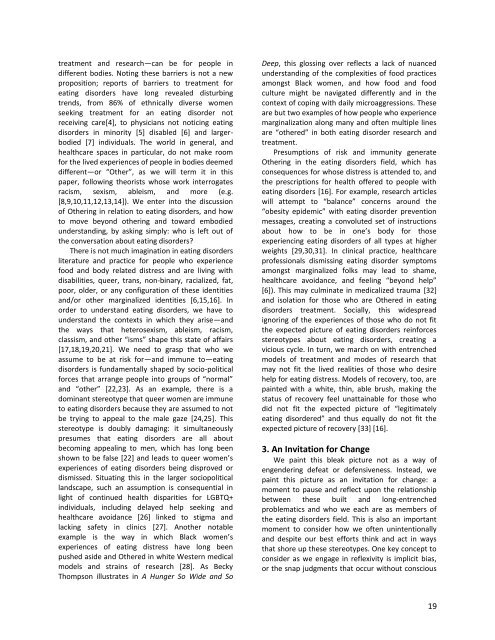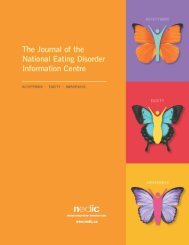NEDIC Conference Journal 2018
Create successful ePaper yourself
Turn your PDF publications into a flip-book with our unique Google optimized e-Paper software.
treatment and research—can be for people in<br />
different bodies. Noting these barriers is not a new<br />
proposition; reports of barriers to treatment for<br />
eating disorders have long revealed disturbing<br />
trends, from 86% of ethnically diverse women<br />
seeking treatment for an eating disorder not<br />
receiving care[4], to physicians not noticing eating<br />
disorders in minority [5] disabled [6] and largerbodied<br />
[7] individuals. The world in general, and<br />
healthcare spaces in particular, do not make room<br />
for the lived experiences of people in bodies deemed<br />
different—or “Other”, as we will term it in this<br />
paper, following theorists whose work interrogates<br />
racism, sexism, ableism, and more (e.g.<br />
[8,9,10,11,12,13,14]). We enter into the discussion<br />
of Othering in relation to eating disorders, and how<br />
to move beyond othering and toward embodied<br />
understanding, by asking simply: who is left out of<br />
the conversation about eating disorders?<br />
There is not much imagination in eating disorders<br />
literature and practice for people who experience<br />
food and body related distress and are living with<br />
disabilities, queer, trans, non-binary, racialized, fat,<br />
poor, older, or any configuration of these identities<br />
and/or other marginalized identities [6,15,16]. In<br />
order to understand eating disorders, we have to<br />
understand the contexts in which they arise—and<br />
the ways that heterosexism, ableism, racism,<br />
classism, and other “isms” shape this state of affairs<br />
[17,18,19,20,21]. We need to grasp that who we<br />
assume to be at risk for—and immune to—eating<br />
disorders is fundamentally shaped by socio-political<br />
forces that arrange people into groups of “normal”<br />
and “other” [22,23]. As an example, there is a<br />
dominant stereotype that queer women are immune<br />
to eating disorders because they are assumed to not<br />
be trying to appeal to the male gaze [24,25]. This<br />
stereotype is doubly damaging: it simultaneously<br />
presumes that eating disorders are all about<br />
becoming appealing to men, which has long been<br />
shown to be false [22] and leads to queer women’s<br />
experiences of eating disorders being disproved or<br />
dismissed. Situating this in the larger sociopolitical<br />
landscape, such an assumption is consequential in<br />
light of continued health disparities for LGBTQ+<br />
individuals, including delayed help seeking and<br />
healthcare avoidance [26] linked to stigma and<br />
lacking safety in clinics [27]. Another notable<br />
example is the way in which Black women’s<br />
experiences of eating distress have long been<br />
pushed aside and Othered in white Western medical<br />
models and strains of research [28]. As Becky<br />
Thompson illustrates in A Hunger So Wide and So<br />
Deep, this glossing over reflects a lack of nuanced<br />
understanding of the complexities of food practices<br />
amongst Black women, and how food and food<br />
culture might be navigated differently and in the<br />
context of coping with daily microaggressions. These<br />
are but two examples of how people who experience<br />
marginalization along many and often multiple lines<br />
are “othered” in both eating disorder research and<br />
treatment.<br />
Presumptions of risk and immunity generate<br />
Othering in the eating disorders field, which has<br />
consequences for whose distress is attended to, and<br />
the prescriptions for health offered to people with<br />
eating disorders [16]. For example, research articles<br />
will attempt to “balance” concerns around the<br />
“obesity epidemic” with eating disorder prevention<br />
messages, creating a convoluted set of instructions<br />
about how to be in one’s body for those<br />
experiencing eating disorders of all types at higher<br />
weights [29,30,31]. In clinical practice, healthcare<br />
professionals dismissing eating disorder symptoms<br />
amongst marginalized folks may lead to shame,<br />
healthcare avoidance, and feeling “beyond help”<br />
[6]). This may culminate in medicalized trauma [32]<br />
and isolation for those who are Othered in eating<br />
disorders treatment. Socially, this widespread<br />
ignoring of the experiences of those who do not fit<br />
the expected picture of eating disorders reinforces<br />
stereotypes about eating disorders, creating a<br />
vicious cycle. In turn, we march on with entrenched<br />
models of treatment and modes of research that<br />
may not fit the lived realities of those who desire<br />
help for eating distress. Models of recovery, too, are<br />
painted with a white, thin, able brush, making the<br />
status of recovery feel unattainable for those who<br />
did not fit the expected picture of “legitimately<br />
eating disordered” and thus equally do not fit the<br />
expected picture of recovery [33] [16].<br />
3. An Invitation for Change<br />
We paint this bleak picture not as a way of<br />
engendering defeat or defensiveness. Instead, we<br />
paint this picture as an invitation for change: a<br />
moment to pause and reflect upon the relationship<br />
between these built and long-entrenched<br />
problematics and who we each are as members of<br />
the eating disorders field. This is also an important<br />
moment to consider how we often unintentionally<br />
and despite our best efforts think and act in ways<br />
that shore up these stereotypes. One key concept to<br />
consider as we engage in reflexivity is implicit bias,<br />
or the snap judgments that occur without conscious<br />
19




